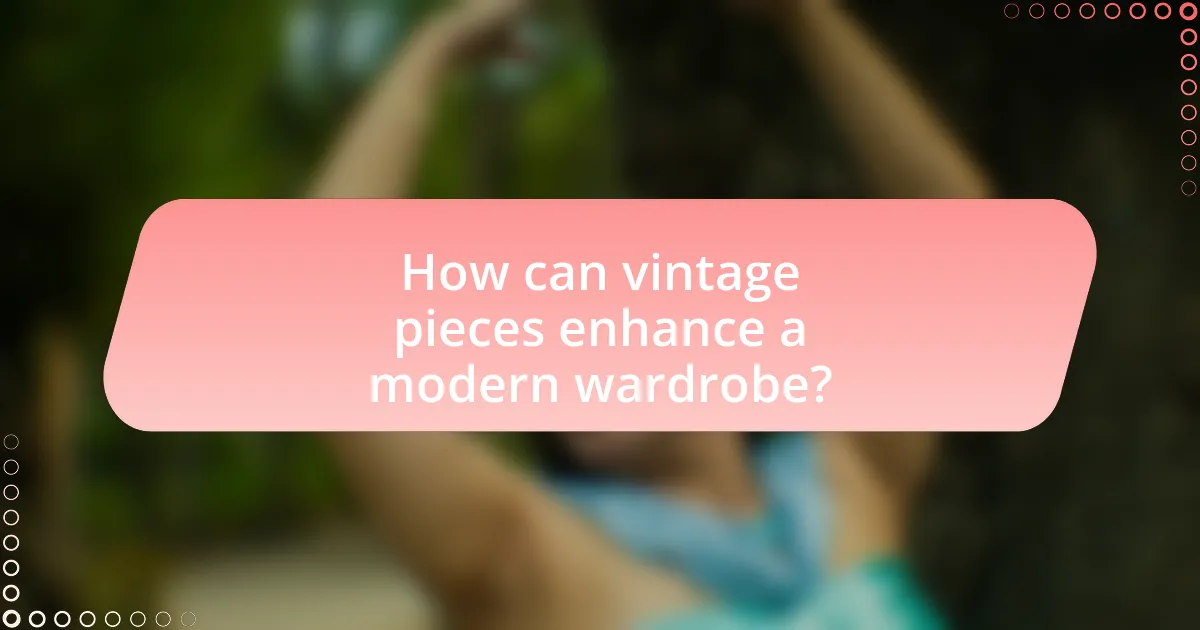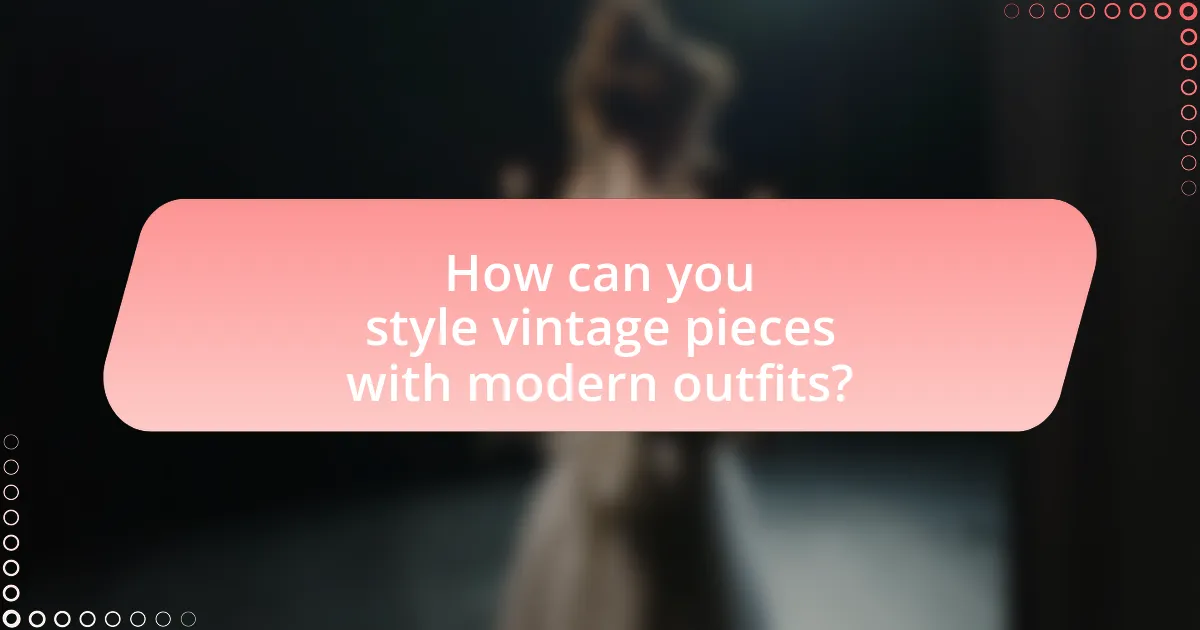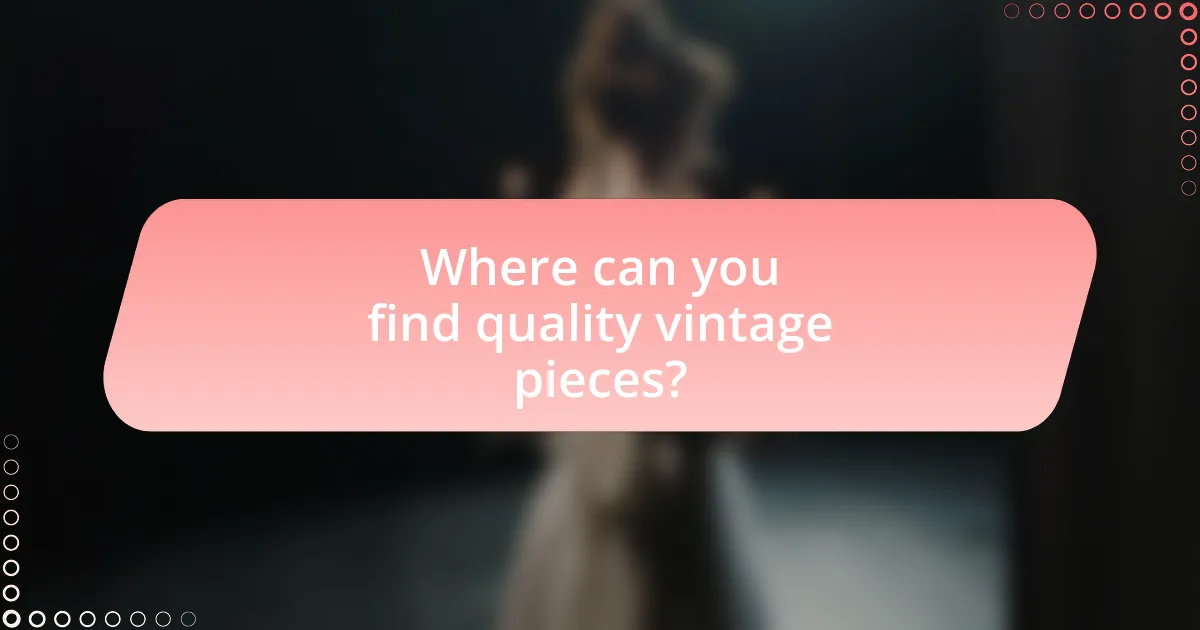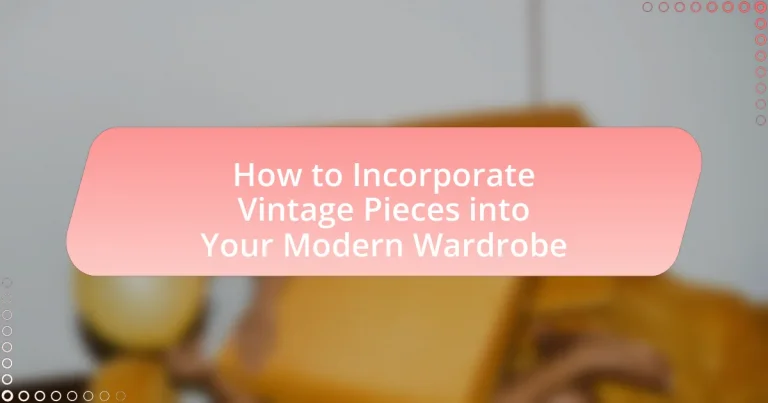The article focuses on how to incorporate vintage pieces into a modern wardrobe, highlighting the unique character and individuality that vintage items can bring to contemporary fashion. It discusses the key characteristics of vintage fashion, the differences between vintage and modern styles, and the most influential eras in vintage fashion. Additionally, the article addresses the benefits of mixing vintage with modern styles, tips for selecting and styling vintage items, and practical advice for maintaining them. It also explores common misconceptions about vintage clothing and provides insights on where to find quality vintage pieces, ensuring readers can effectively integrate these timeless items into their everyday outfits.

How can vintage pieces enhance a modern wardrobe?
Vintage pieces can enhance a modern wardrobe by adding unique character and individuality to outfits. These items often feature distinctive designs, high-quality materials, and craftsmanship that are less common in contemporary fashion, allowing wearers to stand out. For instance, vintage clothing from the 1960s or 1970s can introduce bold patterns and colors that contrast with minimalist modern styles, creating visually interesting ensembles. Additionally, incorporating vintage accessories, such as handbags or jewelry, can elevate a simple outfit, providing a touch of nostalgia and personal style. The blend of vintage and modern elements not only showcases personal taste but also promotes sustainable fashion by encouraging the reuse of clothing.
What are the key characteristics of vintage fashion?
Vintage fashion is characterized by its unique styles, quality craftsmanship, and historical significance, typically referring to clothing and accessories from previous decades, particularly those made before the 1990s. Key characteristics include distinctive silhouettes that reflect the fashion trends of their time, such as flapper dresses from the 1920s or bell-bottom jeans from the 1970s. Additionally, vintage fashion often features high-quality materials and construction techniques that are less common in contemporary fast fashion, contributing to its durability and appeal. The use of bold patterns, colors, and textures also defines vintage pieces, making them stand out in modern wardrobes. Furthermore, vintage fashion carries a sense of nostalgia and individuality, allowing wearers to express their personal style while connecting with fashion history.
How do vintage styles differ from contemporary trends?
Vintage styles are characterized by their historical significance and distinct aesthetics that reflect specific eras, while contemporary trends focus on current fashion sensibilities and modern design elements. Vintage styles often feature unique patterns, fabrics, and silhouettes that were popular in past decades, such as the flapper dresses of the 1920s or the bold prints of the 1970s. In contrast, contemporary trends prioritize functionality, minimalism, and sustainability, often incorporating innovative materials and technology. For example, the rise of athleisure in recent years exemplifies a contemporary trend that emphasizes comfort and versatility, diverging from the more structured and ornate designs typical of vintage fashion.
What eras are most influential in vintage fashion?
The most influential eras in vintage fashion are the 1920s, 1950s, and 1970s. The 1920s introduced flapper dresses and Art Deco styles, reflecting a shift towards modernity and women’s liberation. The 1950s showcased the hourglass silhouette with iconic pieces like petticoats and tailored suits, influenced by designers such as Christian Dior. The 1970s brought bohemian styles and bold patterns, emphasizing individuality and self-expression. Each of these eras has left a lasting impact on contemporary fashion, with elements from these periods frequently reinterpreted in modern designs.
Why should you consider incorporating vintage pieces?
Incorporating vintage pieces into your wardrobe enhances individuality and sustainability. Vintage items often feature unique designs and craftsmanship that stand out in a sea of mass-produced clothing, allowing for personal expression. Additionally, choosing vintage supports sustainable fashion by reducing waste and the demand for new resources; according to the Environmental Protection Agency, textile waste accounts for over 17 million tons in landfills annually. By opting for vintage, consumers contribute to a circular economy, promoting environmental responsibility while enjoying distinctive fashion choices.
What are the benefits of mixing vintage with modern styles?
Mixing vintage with modern styles enhances aesthetic appeal and individuality in fashion. This combination allows for unique expressions of personal style, as vintage pieces often carry historical significance and character that modern items may lack. Furthermore, incorporating vintage elements can lead to sustainable fashion choices, as it promotes the reuse of clothing and reduces waste. Studies indicate that vintage clothing can also be of higher quality due to superior craftsmanship, providing durability alongside style.
How can vintage pieces reflect personal style?
Vintage pieces can reflect personal style by showcasing unique aesthetics and individual preferences that differ from contemporary fashion trends. These items often carry historical significance and distinctive craftsmanship, allowing wearers to express their identity through clothing that tells a story. For instance, a vintage 1970s bohemian dress can highlight a person’s affinity for free-spirited fashion, while a classic 1950s tailored blazer may indicate a preference for timeless elegance. The diversity in vintage fashion enables individuals to curate a wardrobe that resonates with their personal narrative, setting them apart in a sea of mass-produced clothing.
What challenges might arise when integrating vintage items?
Integrating vintage items into a modern wardrobe can present several challenges, including sizing discrepancies, compatibility with contemporary styles, and potential wear and tear. Sizing discrepancies often arise because vintage clothing sizes differ significantly from modern sizing standards, making it difficult for individuals to find well-fitting pieces. Compatibility issues occur when vintage items do not align with current fashion trends, leading to styling dilemmas. Additionally, vintage items may exhibit signs of wear, such as fading or structural damage, which can complicate their integration into a modern wardrobe. These challenges necessitate careful consideration and creativity to ensure successful incorporation of vintage pieces.
How can you ensure vintage pieces fit your modern aesthetic?
To ensure vintage pieces fit your modern aesthetic, select items that have clean lines and neutral colors, as these elements easily blend with contemporary styles. For instance, a vintage blazer in a solid color can complement modern trousers or a minimalist dress. Additionally, accessorizing vintage items with modern accessories, such as sleek handbags or contemporary jewelry, can create a cohesive look. Research indicates that combining vintage and modern elements can enhance personal style while maintaining a balanced appearance, as seen in fashion trends that emphasize eclecticism and individuality.
What are common misconceptions about vintage clothing?
Common misconceptions about vintage clothing include the belief that it is always expensive, that it is only suitable for specific occasions, and that it is always in poor condition. Many people assume vintage items carry a high price tag, but prices can vary widely based on brand, rarity, and condition, making affordable options available. Additionally, some think vintage clothing is only appropriate for events like themed parties or retro gatherings, while in reality, vintage pieces can be seamlessly integrated into everyday outfits. Lastly, the notion that vintage clothing is typically worn out or damaged is misleading; many vintage items are well-preserved and of high quality, often made with superior materials compared to contemporary fast fashion.
How can you effectively mix vintage and modern pieces?
To effectively mix vintage and modern pieces, focus on balancing the styles by selecting one statement vintage item and pairing it with contemporary basics. This approach allows the vintage piece to stand out while maintaining a cohesive look. For instance, wearing a vintage dress with modern accessories like a sleek handbag and minimalist shoes creates a harmonious blend. Additionally, consider color coordination; matching tones between vintage and modern items can unify the outfit. Historical fashion trends show that this method has been successful in various eras, as seen in the resurgence of vintage styles in modern fashion weeks, where designers often incorporate retro elements into contemporary collections.
What are some tips for selecting vintage items?
When selecting vintage items, prioritize authenticity and condition. Authenticity ensures that the item is genuinely vintage, typically defined as being at least 20 years old, while condition affects both the item’s value and usability. Inspect items for signs of wear, such as fraying, discoloration, or structural damage, as these factors can influence both aesthetics and longevity. Additionally, research the brand or designer, as reputable names often hold higher value and quality. Understanding the era of the item can also guide your selection, as different periods have distinct styles and materials. Finally, consider how the vintage piece will integrate with your modern wardrobe, ensuring it complements your existing style and can be worn in contemporary settings.
How do you assess the quality of vintage clothing?
To assess the quality of vintage clothing, examine the fabric, construction, and overall condition. High-quality vintage pieces are often made from durable materials such as wool, silk, or cotton, which have stood the test of time. Inspect the stitching; quality garments feature tight, even seams without loose threads or fraying. Additionally, check for any signs of wear, such as stains, holes, or fading, as these can significantly impact the garment’s value and longevity. Vintage clothing from reputable brands or designers typically reflects superior craftsmanship, further indicating quality.
What should you look for in vintage accessories?
When selecting vintage accessories, prioritize authenticity, quality, and condition. Authenticity ensures the piece is genuinely vintage, often verified through labels, materials, or craftsmanship indicative of a specific era. Quality refers to the materials and construction; vintage items made from durable fabrics or metals often retain their appeal and functionality over time. Condition is crucial; inspect for signs of wear, damage, or repairs, as these factors can affect both aesthetic and value. For example, a well-preserved vintage handbag from the 1960s may feature high-quality leather and craftsmanship, making it a desirable addition to a modern wardrobe.

How can you style vintage pieces with modern outfits?
To style vintage pieces with modern outfits, combine one vintage item with contemporary clothing to create a balanced look. For instance, pairing a vintage blouse with high-waisted jeans or a modern skirt can blend eras effectively. This approach allows the vintage piece to stand out while maintaining a current aesthetic. Additionally, accessorizing with modern items, such as sleek shoes or minimalist jewelry, can enhance the overall outfit without overwhelming the vintage element. This method is supported by fashion experts who emphasize the importance of contrast and balance in styling, ensuring that the vintage piece complements rather than clashes with modern attire.
What are some successful outfit combinations?
Successful outfit combinations include pairing a vintage denim jacket with a modern white t-shirt and tailored black trousers, creating a balanced look that merges old and new styles. Another effective combination is a vintage floral dress with contemporary ankle boots, which adds a trendy edge to a classic silhouette. Additionally, combining a vintage leather skirt with a fitted graphic tee and sneakers offers a chic yet casual vibe. These combinations work well because they blend timeless vintage elements with current fashion trends, allowing for versatile and stylish outfits.
How can you pair vintage tops with modern bottoms?
Pair vintage tops with modern bottoms by selecting contemporary styles that balance the vintage aesthetic. For instance, a vintage blouse can be paired with high-waisted jeans or tailored trousers to create a chic contrast. This approach allows the vintage piece to stand out while maintaining a modern silhouette. Additionally, incorporating modern fabrics, such as denim or structured materials, enhances the overall look, ensuring that the outfit feels current. This method is effective because it combines the unique charm of vintage clothing with the clean lines of modern fashion, creating a harmonious blend that is visually appealing.
What footwear works best with vintage dresses?
Classic pumps work best with vintage dresses, as they complement the elegant silhouette typical of vintage styles. These shoes often feature a timeless design that enhances the overall aesthetic of vintage attire, particularly styles from the 1950s and 1960s. Additionally, ankle boots can also be a suitable choice, especially for more casual vintage dresses, providing a modern twist while maintaining a retro vibe. The combination of these footwear options with vintage dresses creates a harmonious look that respects the original style while allowing for contemporary expression.
How can layering enhance your vintage-modern look?
Layering enhances a vintage-modern look by allowing the combination of different textures, patterns, and styles, creating a visually interesting outfit. This technique enables individuals to mix vintage pieces, such as a classic blazer or a retro dress, with modern items like contemporary jeans or trendy footwear, resulting in a balanced aesthetic that reflects personal style. Historical fashion trends demonstrate that layering has been a staple in various eras, showcasing its versatility and timeless appeal. For instance, the 1970s saw the popularization of layering with bohemian styles, which can be adapted today to merge vintage and modern elements seamlessly.
What are effective layering techniques with vintage pieces?
Effective layering techniques with vintage pieces include combining different textures, mixing eras, and utilizing accessories to create depth. For instance, pairing a vintage denim jacket with a contemporary turtleneck and tailored trousers can blend styles seamlessly. Additionally, layering a vintage dress over a fitted shirt or turtleneck can modernize the look while maintaining the vintage aesthetic. Accessories like scarves or statement belts can further enhance the outfit, adding visual interest and cohesion. These techniques allow for a unique expression of personal style while integrating vintage elements into a modern wardrobe.
How can outerwear complement vintage outfits?
Outerwear can enhance vintage outfits by adding layers, texture, and a modern twist to classic styles. For instance, a tailored vintage coat can elevate a simple dress, while a denim jacket can provide a casual contrast to a retro skirt. Historical fashion trends show that outerwear has always played a crucial role in defining an outfit’s overall aesthetic, as seen in the popularity of trench coats in the 1960s, which complemented the mod fashion of that era. By selecting outerwear that aligns with the vintage piece’s era or contrasts it effectively, individuals can create a cohesive yet dynamic look that honors the past while remaining contemporary.

Where can you find quality vintage pieces?
Quality vintage pieces can be found at specialized vintage shops, thrift stores, estate sales, and online marketplaces such as Etsy and eBay. These venues often curate collections of authentic vintage items, ensuring a diverse selection. For instance, vintage shops typically source their inventory from various eras, providing unique clothing and accessories that reflect historical fashion trends. Estate sales often feature high-quality items from previous owners, while online platforms allow for a broader search across different regions, increasing the chances of finding rare pieces.
What are the best places to shop for vintage clothing?
The best places to shop for vintage clothing include thrift stores, vintage boutiques, online marketplaces, and estate sales. Thrift stores often have a wide selection of affordable vintage items, while vintage boutiques curate unique pieces that reflect specific eras. Online marketplaces like Etsy and eBay provide access to a global range of vintage clothing, allowing shoppers to find rare items. Estate sales can also yield high-quality vintage finds, as they often feature clothing from previous decades. These shopping venues are recognized for their diverse offerings and ability to connect consumers with authentic vintage fashion.
How do thrift stores compare to vintage boutiques?
Thrift stores typically offer a wider variety of second-hand items at lower prices compared to vintage boutiques, which specialize in curated, higher-quality vintage pieces often at a premium. Thrift stores source their inventory from donations and often include everyday clothing, while vintage boutiques focus on specific eras and styles, ensuring that items are in good condition and have a distinct aesthetic appeal. This distinction is supported by the fact that vintage boutiques may charge 50% to 200% more than thrift stores for similar items due to their selective curation and branding.
What online platforms are reliable for vintage shopping?
Reliable online platforms for vintage shopping include Etsy, eBay, and Depop. Etsy specializes in handmade and vintage items, offering a wide range of unique pieces from various sellers. eBay provides a vast marketplace for vintage goods, allowing users to bid or buy items directly, with buyer protection policies in place. Depop focuses on a younger demographic, featuring curated vintage clothing and accessories, and emphasizes social interaction among users. These platforms have established reputations and user reviews that validate their reliability for vintage shopping.
How can you identify authentic vintage items?
To identify authentic vintage items, examine the item’s construction, labels, and materials. Authentic vintage pieces often feature high-quality craftsmanship, unique stitching patterns, and labels that reflect the era they were made in, such as specific brand tags or care instructions that were common at the time. For example, clothing made before the 1980s typically has a union label, indicating it was made in the USA under specific labor conditions. Additionally, researching the brand’s history can provide insights into the authenticity of the item, as many brands have distinct characteristics that evolved over time.
What labels or tags should you look for?
When incorporating vintage pieces into a modern wardrobe, look for labels or tags that indicate authenticity and quality, such as “vintage,” “made in [specific country],” or specific designer names. Authentic vintage items often have tags that denote their era, such as “1970s” or “1980s,” which can help in identifying the piece’s historical context and style. Additionally, tags that mention materials like “100% silk” or “wool” can indicate higher quality, which is often found in vintage clothing. Recognizing these labels ensures that you select pieces that not only fit your style but also maintain the integrity and craftsmanship associated with vintage fashion.
How can you spot reproductions or fakes?
To spot reproductions or fakes, examine the item’s materials, craftsmanship, and markings. Authentic vintage pieces typically use high-quality materials and exhibit superior craftsmanship, while reproductions often utilize cheaper materials and exhibit signs of mass production. Additionally, check for specific markings or labels that are characteristic of the original manufacturer; for example, many vintage items have unique tags or stamps that can be verified through historical records. Researching the item’s provenance can also provide insights into its authenticity, as genuine vintage pieces often have a documented history.
What are some practical tips for maintaining vintage clothing?
To maintain vintage clothing effectively, it is essential to store items properly, clean them gently, and handle them with care. Proper storage involves keeping vintage garments in a cool, dry place away from direct sunlight to prevent fading and deterioration. Cleaning should be done using mild detergents and cold water, as harsh chemicals can damage delicate fabrics. Additionally, it is advisable to avoid machine washing; instead, hand wash or use dry cleaning when necessary. Handling vintage clothing with clean hands and avoiding excessive pulling or stretching will help preserve the integrity of the fabric. These practices are supported by textile conservation guidelines, which emphasize the importance of careful maintenance to extend the lifespan of vintage garments.


